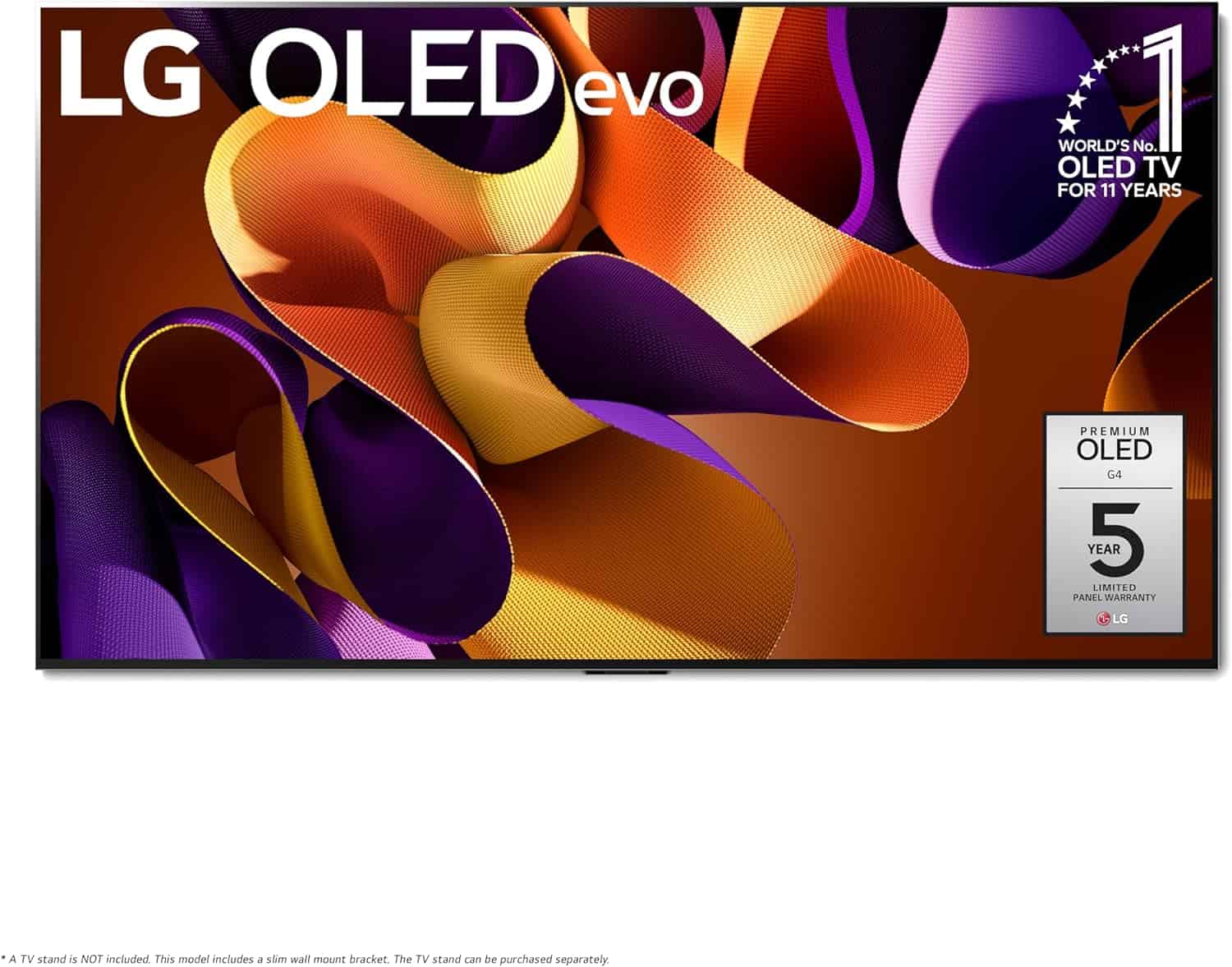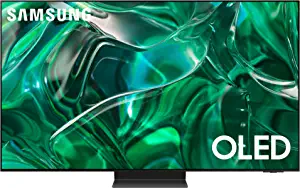LG G4 OLED vs Samsung S95C – is the S95C better?

Table of Contents
After a successful introduction to the world of OLED tech in 2023, the Samsung S95C stands as a formidable QD-OLED TV that positions itself as a strong contender. With the upcoming release of the next-gen LG OLED TVs in 2025, LG may be giving Samsung a run for its money with new impressive products like the LG G4. In this article, we’ll take a look at the LG G4 OLED vs Samsung S95C, covering specs, performance, and price, to ultimately help you decide which is the better TV for you.
In the ever-evolving consumer electronics landscape, the rivalry between LG and Samsung has long been a hallmark of innovation and technological advancement. Both giants have been at the forefront of OLED displays, pushing the boundaries of visual excellence and immersive viewing experiences. Let’s take a closer look at some of their features!
But first, if you’re keen to find out more info on LG’s upcoming OLED releases, then take a look at our LG G4 release date round-up, where we discuss the expected release date window of the product and go into detail on some of this LG display’s features. Additionally, if you’d like to see how some of the new LG products compare to older TVs in the lineup, take a look at our LG G4 vs LG G1 comparison guide, where we see how far the G-series has come in 3 years
LG G4 OLED vs Samsung S95C – specs at a glance
| Specifications | LG G4 OLED | Samsung S95C |
|---|---|---|
| Panel Technology | MLA OLED | 97″ – WOLED | OLED |
| Processor | Alpha 11 AI processor | Neural Quantum Processor 4K |
| Resolution | 4K | 4K |
| OLED glare-free | No | No |
| Refresh rate | 120 Hz (Up to 144 Hz) | 120 Hz (Up to 144 Hz) |
| HDR compatibility | HDR 10+ | HDR 10+ |
| Peak brightness | Up to 3,000 nits | Up to 2,000 nits |
| Screen sizes available | 55, 65, 77, 83, 97 | 55, 65, 77 inches |
Specs
When comparing the LG G4 OLED and the Samsung S95C, both televisions boast cutting-edge OLED panel technology and offer remarkable features for immersive viewing experiences. Let’s delve into the specifications to understand their differences and assess which might be a better choice for you.
In terms of panel technology, both the LG G4 OLED and the Samsung S95C utilize OLED displays, which are renowned for their vibrant colors and wide viewing angles. Both TVs offer 4K resolution, ensuring crisp and detailed images. The Samsung features a third-generation QD-OLED panel that has improved upon the previous Samsung OLED technology, providing deeper blacks and more vivid colors. Whereas, the LG G4 is an OLED panel that utilizes new MLA technology (Micro lens array), which provides a brightness upgrade over previous models in the G-series – promising to enhance the brightness up to 150% for HDR highlights.
Regarding processing power, the LG G4 OLED is equipped with the Alpha 11 AI processor, while the Samsung S95C features the Neural Quantum Processor 4K. While both processors are designed to enhance picture quality and overall performance, specific details about clock speeds, core counts, and other technical aspects are not provided here. However, both are likely optimized for handling 4K content and enhancing overall picture quality.
Features
The refresh rate is identical for both TVs, with a maximum of 120 Hz (up to 144 Hz), ensuring smooth motion handling, especially beneficial for gaming and fast-paced action scenes. Regarding HDR compatibility, both TVs support HDR 10+, which allows for enhanced contrast and color accuracy in HDR content.
The LG G4 OLED offers a higher peak brightness of up to 3,000 nits compared to the Samsung S95C, which peaks at 2,000 nits. This could result in the LG G4 OLED delivering brighter highlights and more vivid HDR content, potentially providing a more dynamic viewing experience, especially in well-lit rooms.
Regarding screen sizes, both models offer various options, catering to different room sizes and preferences. However, LG G4 offers a wider range of larger models, from 55-inches to 97-inches. Whereas Samsung offers smaller sizes ranging from 55 to 77 inches. To see all TV sizes for each brand, view the table below.
Performance comparison
The performance of the LG G4 OLED is likely to be more predictable and reliable due to the known specifications of its Adreno 430 GPU. With its clock speed and support for various graphics APIs, it should offer smooth performance in gaming and other graphics-heavy applications.
In contrast, the performance of the Samsung S95C may vary depending on the specifications of its GPU. Without detailed information on its clock speed, memory size, and other key factors, it’s challenging to determine how well it will perform compared to the LG G4 OLED.
Price comparison
The LG G4 OLED may offer better value for users who prioritize performance and reliability in their TVs. With its known specifications and performance capabilities, it can provide a satisfying gaming and multimedia experience.
On the other hand, the Samsung S95C’s value proposition is less clear without detailed information on its GPU and performance capabilities. It may or may not offer competitive value depending on its price relative to the LG G4 OLED and its actual performance in real-world usage scenarios.
Prices at the time of launch for LG G4 and Samsung S95C:
| Screen size | LG G4 OLED | Samsung S95C |
| 55-inch | $2,600 | $2,499 |
| 65-inch | $3,400 | $3,299 |
| 77-inch | $4,600 | $4,499 |
| 83-inch | $6,500 | n/a |
| 97-inch | $25,000 | n/a |
These are the prices during the launch of these respective OLED TVs. However, the official pricing of the Samsung S95C has declined a little with the announcement of the upcoming S95D. The Samsung S95C TV models are now available at $1,799.99, $2,299.99, and $3,499.99 for 55-inch, 65-inch, and 77-inch, respectively.
LG G4 vs Samsung S95C – which is better?
Both the LG G4 OLED and the Samsung S95C are premium OLED TVs with impressive specifications. They offer similar price ranges for similar OLED features. The choice between them may be personal preference, specific needs, and budget considerations. Before deciding, consumers may want to compare additional factors such as design, user interface, smart features, and overall ecosystem compatibility.
When is the LG G4 coming out?
With no official release date announced by LG, consumers are left to speculate as to when the LG G4 will arrive this year. By looking at past G-Series release date patterns and making predictions that align with the G4’s predecessors, it’s expected that the G4 may arrive in March this year. However, it’s important to note that this is all speculation, and until LG has confirmed we can’t be 100% sure.
LG G4 OLED vs Samsung S95C – conclusion
LG and Samsung are making waves in the world of OLED technology and are certainly at the forefront of high-end TV advancements. As outlined in this article, the choice between the LG G4 and Samsung S95C is not clear-cut. They both offer impressive features that would suit a consumer looking for the most out of their TV. So, the decision mainly comes down to personal preference and budget constraints. We hope this Samsung vs LG comparison guide has helped you in any decision-making process. If you’d like to stay in the loop regarding the upcoming release of the LG G4, then stick with us as we keep up-to-date on all the updated info.


